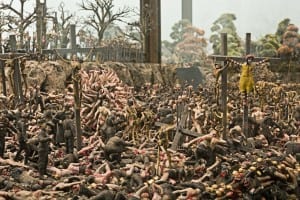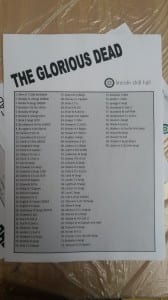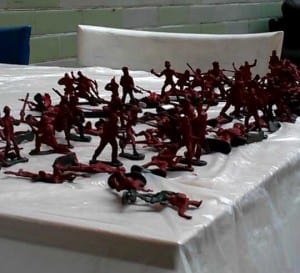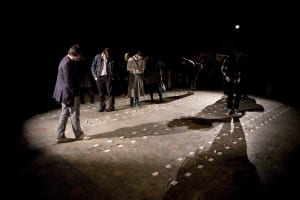Framing Statement
The Glorious Dead was a site specific performance that was inspired by and performed at Lincoln Drill Hall on Friday 8th May 2015. The performance was an 85 minutes piece with a pre-performance and post-performance, this was intended to take roughly 3 hours long.
The performance was located in the café in the Drill Hall. As soon as customers walk through the entrance to the café, their sight is immediately directed towards the staging area and the war memorial that overlooks the seating in the café. We decide to base the performance here and create a performance based on this war memorial. On the memorial it says:
In MEMORY of THE GLORIOUS DEAD of the 4th BN LINCOLNSHIRE REGIMENT
Using this plaque as inspiration for our performance we decided to remember those solider lost. We wanted to create a strong visual image using toy soldiers. To represent the 85 soldiers that lost their lives in WW1, 85 toy soldiers would be painted red.
Pre-performance
In the pre-performance 705 toy soldiers were set up. The toy soldiers were primarily on the stage but there would also be some soldiers placed in the furniture of the café, for example the flower pot. Also on each table there was a list of all the 85 soldiers that died in the 4th battalion in the centre as well as a programme with some of the research we found. We were aware this is a working café so in the pre-performance we had warning signs up stating there would be a gunshots within this performance. We set aside 1 hour to complete these tasks, started at 2pm and finished at 3pm and as performers we were able to talk to one another through the pre-performance. Within one of our rehearsals we timed and recorded this process.
https://www.youtube.com/watch?v=O9yTmCeD3no
(Jones, 2015)
Performance
The performance itself consisted of 3 stations:
- The performer picked up a soldier, sat to the left of the stage turned the sand timer over and waited for one minute to pass. Once the gun shot sound was played on the laptop, move to the next station.
- They then painted a toy soldier red to symbolise the soldiers death, say the name of one of the soldier’s names that was written on a piece of paper and crossed it off with the red paint.
- They took the painted solider to the table directly below the memorial and placed it on the clear dust sheet, that was placed on top of the table and look up at the memorial.
We expected the performance to last 85 minutes to represent a minutes silence for each soldiers that died in the 4th battalion of the Lincolnshire regiment.
We wished anyone who wanted to watch and remember to do so. We realise that our performance will be in a working cafe that will still be expecting customers. Customers were welcome to document the performance by taking pictures if they wished to do so.
Post-performance
The post-performance involved clearing away all the unpainted soldiers, leaving the red painted soldiers on the table below the war memorial as a final image. 35 minutes were set aside to complete this task, thus making the whole performance 3 hours long.
Costume
We all wore black funeral wear clothes that we would wear now. We wanted to almost modernise our clothing because remembrance is still part of everyday life now. We still remember the soldiers lost across the generations from WW1 to now and is something that will continue for generations to come. Through the costume and location of the performance we are able to “attempt to record and represent the substance […] through juxtapositions and interweaving of the historical and the contemporary” (Pearson, 2010, 32). We also wore red lipstick and red nails to highlight the increased amount of bloodshed as more soldiers were painted.
Analysis of Process
Before creating any site specific performance it is important to “research the history of the site, the architecture and the lives of its inhabitants” (Pinchbeck, 2006) and previous inhabitants, this can be the inspiration for the performance. By looking at the history of Lincoln Drill Hall I began to realise the significance of the building and felt it necessary to “offer up new understandings of the location and practises within the site” (Govan et al, 2007, 122). By researching into the current and previous use of each space I was able to maintain a sense of “respect the space [I was] in, and its present function” (Brewis, 2014). This enabled us to devise a performance that fully incorporate the site. We were particularly interested in those lives lost in WW1, as many of those soldiers trained at Lincoln Drill Hall. We began to experiment with the flexibility and restrictions of each space. Depending on the location we would add or take away meaning to the performance. To begin with we favoured the Room Upstairs, especially as originally the room was used to hold meetings amongst the generals of the army. Even now in the room there is a clear trace of this key part of history, there is one section of the wall that is stained yellow due to the tobacco smoked. The idea we devised using the Room Upstairs was to create a one to one performance. The audience would sit in the middle of the dimly lit room with toy soldiers pointing their guns as the spectator. On the floor we would try to recreate the battle field with soldiers scattered everywhere. In the centre of the room would be a table and chair, where the audience member would sit, on the table there would be a miniaturised version of what was happening in the room upstairs. In the café they have a small memorial of 9 soldiers who died in WW1, through the use of headphones, the spectator would listen to the stories of each soldier. However due to the lack of information we could find on each of these soldiers, both through online and Lincoln archives, we changed the idea by performing in the piece and simplifying the idea. This idea was also criticised as we were not performing ourselves in the piece, mainly due to the fact we were planning on asking male performers to be the 9 soldiers telling their stories.
After further deliberation, we decide to literally use the war memorial to make a clear link to these toy soldiers and the Drill Hall. Since the memorial is located in the café this would add another level to our performance to “draw into juxtaposition with […] other things” (Pearson, 2010, 32) i.e. the juxtaposition of the modern location and the historical facts of the soldiers deaths. Using the café, we were able to juxtapose the historical war time tragedy and the modern day use of the space. To cause as little disruption as possible within the café, we decided to centre the performance on the stage space at all times and one table situated directly below the memorial.
The idea of using toy soldiers, for me, developed very early on in the process. I was influenced by Andy Field’s production of Zilla! (2013). Field used Lego men to miniaturise a city as the audience looked at the city from a great height “from above, imagining the people far below like ants” (Field, 2013). Similarly, since one of the key historical events that happened in the Drill Hall was that it was used to train soldiers from Lincoln and the surrounding villages, I felt making an instillation of toy soldiers would create the same effect Field created. The aim was to also give a physical representation of the soldiers that had passed through and died as a result of the war. Using over 700 soldiers would help emphasise the scale of how many soldiers would have passed through the Drill Hall.
In keeping with idea of toy soldiers, I was also heavily inspired through Jake and Dinos Chapman’s grotesque instillations. They often use small plastic figures to explore contemporary political and moral views to create a large scale instillations. I was particularly drawn to their exhibit Hell (1999), as seen below, whereby it is difficult to comprehend the devastation and destruction of all the soldiers. The instillation “depict[s] scenes of excessive brutality involving Nazi soldiers, and in more recent works, McDonald characters” (Chapman, 2013, 2). We became particularly inspired by all of their work, particularly Hell as “their graphic, animalistic work compels viewers to engage viscerally in its messaging” (Hagel, 2014). We were inspired by their gruesome work so much so that one of our ideas was to find out exactly how each soldier died, and physically show their cause of death. This would have been done by painting the body part that was their original cause of death and brake that body part of the toy soldier. However, after looking into the logistics of this idea, we were unable to find the exact cause of death for most of the soldiers. Also, after buying the soldiers we realised it was a lot more difficult than anticipated to break the soldiers. As well, needed to remember that the site is not the battlefield where the soldiers died, it is where they trained. Keeping the site in mind at all times create a site specific performance whereby the “performance and place are invested in one another” (Kaye, 2000, 55)

(Westall, 2013)
Since we reached the basic idea early on the in the process, this gave us time to fine tune and play around with other ideas. We particularly wanted to look at the use of different aesthetics and the effect that had on the performance. Towards the end of the process this became our key focus. We experimented with the idea of introducing new visual tools. For example, chalk and a blackboard that pre-existed in the café, or incorporating the material we already have into the performance more. We needed to visually show the audience how many soldiers we had painted. One idea was to incorporate bricks which would blend into the architecture. These bricks would create a stairway leading up to the memorial. The idea was in the post- performance instead of leaving the soldiers on the table we would place them on this stairway leading to the memorial. However after looking at the practicalities of the use of bricks, we began to realise it would work for health and safety reasons as we would not have used cement. Also the logistics of getting them would be a problem as they were too expensive, especially seeing as we only had a small amount of our budget left. As well as storing the bricks and getting those to the Drill Hall would be a problem. James Hillier believed that “sometimes you’re not able to fulfil every choice that you’d like to make” (Brewis, 2014). We decided to return to the original idea that worked.
I became aware of the positioning of the audience through the performance. Due to the fact we were located in a working café, we were unsure if at all times someone would be watching the performance. Through researching current artists that explore the significance of audience members, I began to question the necessity of any number of audience members while we were performing. In Antony Gormley’s Domain Fields the performance was not the humanistic sculptures he created, he believed the act of someone walking through the sculptures was the performance as the sculptures “call upon our conscious, our feeling, our movement and we become part of the work.” (Gormley, 2009). I began to question if our piece with the toy soldiers needed an audience. With audience members in the space would create a different meaning to the performance as it would juxtapose us ‘killing’, i.e. painting the soldiers red with everyday life. Focusing on the relationship between space and spectators I began to “question the relationship between the audience and the performers” (Govan et al, 2007, 135). Would this alter the original idea of just remembering the dead? How would the audience know they are in a performance? After experimenting with the incorporation of the audience we felt we should not involve them with the performance, instead there would be soldiers scattered around the space and the names of those soldier were read out.
Towards the end of the process I still felt the sight and the performance should be intertwined more, especially as site specific performances should mean the “performance and place are invested in one another” (Kaye, 2000, 55). To incorporate the café more into the performance we decided to create a running narrative. In order to make it more personal for the spectators we printed off the list of soldiers and placed it on each table. We also created a small programme to show some of the research we had completed, both of which we in keeping with the style of the programme and menu thus integrating our performance with the site more.

(Hollier. 2015)
Performance Evaluation
By looking at theoretical concepts and practitioners who devised site specific work, I have developed my understanding of what performance is. Performance does not have to involve acting or staging, in its simplest form performance can be anyone carrying out a pre-determined set of actions. Site specific performance has made me realise that any location can become a performance space, and you do not need to be a professional actor in order to create this type of performance. I have come to realise that research is an integral part of any informative performance. Research into any site, topic, or city is at the core at many site specific performances.
Our performance saw miniature toy soldiers being painted red to symbolise their death and being put to rest. In the final performance as we painted more soldiers and got more blood on our hands it created a strong image of the amount of bloodshed in the war. On reflection throughout the performance, I began to realise the use of the 3 stations and continuous repetition of this production line brings to question if we become numb to the continuous ritual of remembering soldiers who we do not know. The motion of remembering becomes dehumanised. After completing the cycle a few times I began to feel very guilty as I took the soldiers identity so the soldier just became a number, especially when I painted over the soldier’s eyes.
Throughout the rehearsal process we had a clear idea on the content of the performance but I was unsure if the beginning and end of the performance was clear enough. When working in the cafe we had “to work hard to distinguish [the performance], to indicate that it has come into being … [and when it] has completed its business.” (Pearson, 2010, 141) Reflecting on the performance I am still unclear if the pre and post-performance were clear enough. We had not considered the effects of the café closing at 3pm would have on the number of audience members. At any one time there would be between 1 and about 8 audience members. This meant when we spoke to each other in pre and post-performance our voices seemed too loud so spoke very little. I felt this did not distinguish the actual performance very well. I think I we were to do this again I would try to highlight the performance more, perhaps, through a loud clear sound. I also think the performance may have been more effective if we had timed the performance to be on while the café was open. This would have created a larger juxtaposition between the modern setting and historical period.
The performance was a durational piece which was supposed to last the full three hours. However when we set out and packed away the soldier it took a lot less time than anticipated, therefore we finished an hour early. Placing the soldiers out only took roughly 20 minutes as opposed to 1 hour and packing the unpainted soldiers away only took 10 minutes as opposed to the 30 minutes. We kept the painted soldiers uncovered as the final image the audience would see and kept the soldiers on the table until 5pm when all the other performances finished. This was not a problem as we continued to the schedule to make the pre and post-performance flow to the performance.
Works Cited
Brewis, B. (2014) James Hillier on directing site-specific theatre. [online] Ideastap. Available from http://www.ideastap.com/IdeasMag/the-knowledge/james-hillier-directing-site-specific-theatre [Accessed 1 May 2015]
Chapman, J. (2013) Come and See. London: Koenig Books.
Field, A. (2013) Zilla! [online] Available from http://www.andytfield.co.uk/home/?p=10 [Accessed on 19th March 2015]
Field, A. (2011) Zilla! [Part 1] Images» ZILLA PT_1_002. [online image] Available from https://lookingforastronauts.wordpress.com/2011/04/06/zilla-part-1-images/zilla-pt_1_002/ [Accessed on 12th May 2015].
Gormley, A. (2009) Antony Gormley: DOMAIN FIELD, GARAGE CENTRE FOR CONTEMPORARY CULTURE, MOSCOW, 2009. [online] Available from: http://www.antonygormley.com/show/item-view/id/2283/type/solo [Accessed 3rd May 2015]
Govan, E., Nicholson, H., Normington, K. (2007) Making a Performance: Devising Histories and Contemporary Practices. Oxon: Routledge.
Hagel, C. (2014) JAKE AND DINOS CHAPMAN DHC/ART Montreal, Montreal, Canada. Art Papers Magazine, 39 (4) 56.
Hollier, K. (2015) List of all the soldiers lost.
Hollier, K. (2015) The Glorious Dead.
Kaye, N. (2000) Site-specific art: performance, place, and documentation. London: Routledge.
Jones, C. (2015) Site Specific The Glorious Dead. Available from https://www.youtube.com/watch?v=O9yTmCeD3no [Accessed on 12th May 2015]
Pinchbeck, M (2006) Nottdance toolkit. Nottingham: Dance4.
Pearson, M. (2010) Site Specific Performance. Basingstoke: Palgrave Macmillan
Westall, M. (2013) GOSEE: Jake & Dinos Chapman ‘Chicken’ @PinchukArtCentre. [online image] Available from: http://fadwebsite.com/2013/02/18/gosee-jake-dinos-chapman-chicken-pinchukartcentre/ [Accessed on 12th May 2015].


